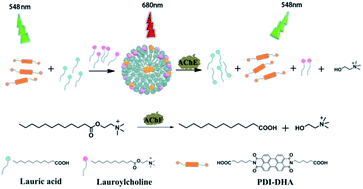A ratiometric fluorescence assay for acetylcholinesterase activity and inhibitor screening based on supramolecular assembly induced monomer–excimer emission transition of a perylene probe†
Abstract
A ratiometric fluorescence assay for acetylcholinesterase activity is established, which is based on controlled perylene probe assembly and monomer–excimer transition. In a buffer solution, a perylene probe with two negatively charged groups (PDI-DHA) mainly exists in monomeric form. In the presence of cationic lauroylcholine and lauric acid, PDI-DHA can form supramolecular assemblies and the perylene excimer emission can be observed. AChE can catalyze the hydrolysis of lauroylcholine to anionic lauric acid and choline. The hydrolysis process can trigger the breakdown of the supramolecular assemblies. The perylene excimer recovers to the monomeric form because of the de-aggregation of the probe. The excimer–monomer transition can be detected, and a ratiometric fluorescence assay for AChE activity and inhibitor screening is therefore established.

- This article is part of the themed collection: Editors’ collection: Supramolecular Chemistry


 Please wait while we load your content...
Please wait while we load your content...